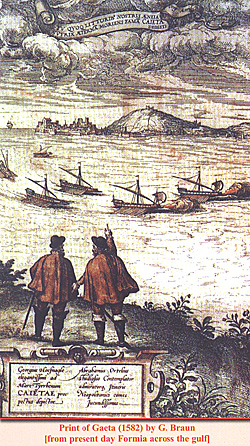 Fortress Gaeta
Fortress Gaeta
Gaeta is a small port town located on a small peninsula along Italy’s west coast, 50 miles north of Naples some 60 miles south of Rome. Fortified first by the Romans and improved upon every century. A fortress built upon thousands of years of fortifications, last modernized by the Bourbons as an arsenal port with walls and cliffs the entire way round.
Print of Gaeta (1582) by G. Braun [from present day Formia across the gulf]
In 1799 during the first French invasion, Gaeta was the site of battle and a seige. In 1806, the Bourbons supported by the British fleet, compelled the French to conduct a formal siege operation, before the Bourbon Kingdom of Naples could be subdued and given to Joseph Bonaparte. In 1808, the kingdom was given to Joachim Murat and Caroline Bonaparte. In 1815, Gaeta again fell under siege, this time from the allies and with a totally unexpected result.
In 1815, Murat’s Neapolitan Army attacked the Austrians in his attempt to conquer Italy, and to save his throne. As this campaign was lost, Murat fled and went into exile, Napoleon fought the Waterloo campaign and then he too went into exile. Everywhere else in Europe peace was restored, except for the last bellicose events of the Napoleonic era that continued to trouble some.
It was in this small town, Gaeta, that a little known Neapolitan commander, with unrenowned Neapolitan troops of indifferent quality, took on the victorious Austrian army, the undefeated British Navy, Queen of the seas, and the returning Bourbons, fighting a long remarkable battle and siege, until the commander himself dictated his own terms months after Waterloo.
In November of 1814, King Murat of Naples placed the fortress town of Gaeta under the command of General Alessandro Begani. Begani began placing Gaeta into a state of readiness, gathering provisions, constructing new works, making repairs, and digging trenches. He noted that armaments to fort were insufficient.
Early in 1815, Murat decided to force war on Austria, hoping to claim Italy as his kingdom. The campaigns’ battles reached a high point at Occhiobello, and the defeat at Tolentino, which ended in the retreat and disintegration of Murat’s Neapolitan army.
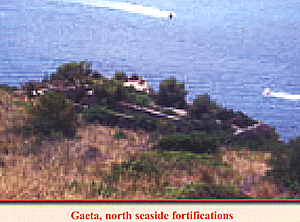 As a Result of the War
As a Result of the War
Begani’s involvement in the war started with sending troops to the Liri river to oppose the Austrians.
Gaeta, north seaside fortifications
The troops joined the command of Neapolitan General McDonald and were soon defeated and the remnants of the 12th of line found themselves pursued as they retreated on Gaeta. On the 12th of May Begani came out of Gaeta with 400 men of the 10th of line and 2 cannon to sustain the 12th’s re-entry into Gaeta.
On May 13, Austrian cavalry outposts were established along the coast and in Borgo (current day Formia) and Mola of Gaeta, a suburb area. Later British ships started a naval blockade of Gaeta, cutting it off from the sea as well. Begani was not idle, as he ordered the destruction of all sheds, houses, shops and all cover outside Gaeta’s walls. [Begani’s Garrison Appendix 1]
On the 19th, LtCol Ghequier of the Austrian army arrived and approached Gaeta’s outposts. No one believed that Gaeta or the Neapolitans would be resolute. Austrian reinforcements of a battalion of Tuscan infantry, 4 companies of the Vacquant Regiment, 2 platoons of the Prince Regent Hussars, and a platoon of Tuscan Dragoons joined the advance guard horsemen and LtCol Ghequier.
Elsewhere in the reign, Murat had already left the army, going to Naples by horse, then by boat to Ischia and onwards to France. Murat’s army officially surrendered after the Convention of Casalanza was signed on May 22nd. Provisions of the treaty allowed the principal fortress commanders of Ancona, Pescara, Naples, and Gaeta, the liberty of how they were to conduct their surrender.
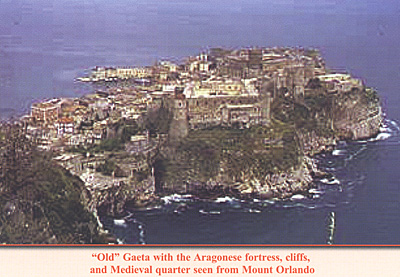 The Neapolitan Army Surrenders, Why Won’t He?
The Neapolitan Army Surrenders, Why Won’t He?
On 22 May 1815, couriers arrived with the news of the capitulation and it’s terms. Major Belaghi of the Tuscan Dragoons and an English officer informed General Begani of the Casalanza Convention and the return of the “true King” of Naples Ferdinand, to the throne. Begani’s response was that he was interested in the affairs of Gaeta, not elsewhere.
“Old” Gaeta with the Aragonese fortress, cliffs, and Medieval quarter seen from Mount Orlando
Murat had instructed him to defend Gaeta, and until a formal order from Murat was received, he would. Colonel Ghequier was astounded, and called on Marshal Bianchi for supplies and instructions because of Begani’s unexpected reply.
Within Gaeta, General Begani called his officers together and instructed them “to maintain calm, courage, and the patriotism of the garrison”. British Captain Fahie decided to send a second envoy with Ghequier on the morning of 25 May in a further attempt to solicit surrender. Begani refused to hear the entreaties.
Correspondence from Lord Bughersh to Lord Castlereagh, Naples, 26 May 1815; “Tranquility reigns in all places, but the commander of Gaeta obstinately refuses to surrender it”. Ghequier sent word to Marshal Bianchi, requesting the “Argenteau” battalion to be placed under his command, he also told of fears brought to him that Murat was still in Ischia and Begani awaited him with confidence, in spite of bombardment and desertions.
One of Begani’s largest problems was in fact a continual number of desertions from inside Gaeta. Guards were doubled from different units to attempt to prevent the desertion of the guards themselves. Later this problem increased substantially.
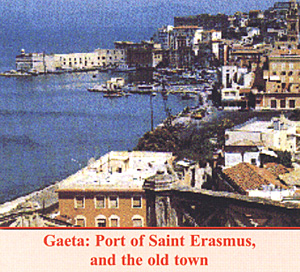 On May 28, Marshal Bianchi ordered
Major General Rebrovich to replace LtCol
Ghequier and take up the blockade of Gaeta.
Upon his arrival he and Captain Fahie agreed
on measures to demoralize the defenders of Gaeta.
On May 28, Marshal Bianchi ordered
Major General Rebrovich to replace LtCol
Ghequier and take up the blockade of Gaeta.
Upon his arrival he and Captain Fahie agreed
on measures to demoralize the defenders of Gaeta.
Gaeta: Port of Saint Erasmus, and the old town
During the 28th the English conducted a violent bombardment lasting into the 29th. Begani sent a message to the new Austrian commander; “I am faithful to defend the fortress for Joachim Napoleon (Murat)”.
Begani’s response followed an attempt by the officers and men of the 10th line to advocate surrender the night of 28 May.
On 29 May, Marshal Bianchi met with Lord Exmouth in Naples on the subject of Gaeta. Bianchi admitted that many more days of resistance were possible. Later Bianchi told Rebrovich that he was to put an end to Gaeta’s resistance as soon possible, not to attack, but to make the populace and garrison aware that resistance was futile. Begani was sent further communications but refused to acknowledge.
An Internal Revolt and an Attempt Against Begani’s Life
A plan was developed by Rebrovich to secretly address Major Nicolini, Begani’s Chief of Staff, with a letter from Ribrovich during a meeting, that the Neapolitan General in Chief Ferdinand had arrived in Naples. He was to ask Nicolini to deliver the surrender request to the other officers. Begani still refused to surrender as he explained to Rebrovich’s officer Col Fleischer; “if the garrison accepted capitulation, it was to be under the convention of Casalanza”.
On 31 May, the 10th of Line and the Legionnaires of Legion Terra di Lavoro, abandoned their posts and called on the garrison to revolt led by Nicolini and several officers. Begani quickly responded, establishing order anew, disarming the mutineers and imprisoning all their leaders. Later during the British bombardment, part of the mutineers broke free and ran towards Austrian lines (1-200 deserted according to sources).
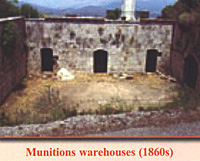 Munitions warehouses (1860s)
Munitions warehouses (1860s)
Begani responded by letter to Rebrovich telling of his knowledge of the letter to Niccolini, stating that he had thought “his adversaries more honorable than common assassins”. Begani put several to death, imprisoning the remainder.
With water now becoming a problem, Begani began distributing other supplies from the State Magazines such as sugar, salt, and tobacco to encourage the soldiers.
On 2 June, Bianchi reported “the refusal of Gaeta to surrender persists, notwithstanding a revolt, and the desertion of 200 men. Some 800 men rest in the garrison.” On the same day two of Begani’s gunboats deserted to the British. Begani brought the remainder of the naval crews inside the fortress. Between the second and third Begani released the inhabitants and rebels to go, he asked those rebels who wished to redeem themselves to rejoin the garrison and that they would be fully pardoned.
Begani’s New Course of Action
On the 3rd of June, another British nego-tiator was sent to Begani by sea, having been ordered by British parliamentarians in an attempt to obtain terms. Begani made clear his response by firing numerous cannon at both the British fleet and at the Austrian positions. Several Austrian guns were dismounted and a brisk fire broke out at the Borgo and Cappuccine Convent. On the fifth of June a letter was sent to Begani from the Maquis Saint Clair asking for common sense. All surrender entreaties to no avail.
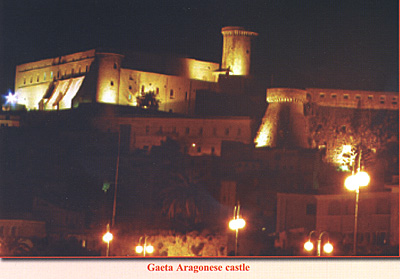 Gaeta Aragonese castle
Gaeta Aragonese castle
From this date onwards, Begani mounted a brisk defense, making it much more hazardous for the Austrians and the British. Rebrovich asked Bianchi to be relieved, citing failing health and requested to retire to Capua. Once again LtCol Ghequier found himself in charge of the siege awaiting Colonel Ruber of the Argenteau regiment to take over.
Austrian forces were redirecting their efforts against France, and with the commencement of operations troops from Gaeta were ordered north. The Weidrunkel regiment was ordered to Gaeta to replace troops being pulled out. A battalion of Chasseurs was to remain until relieved by Neapolitan Bourbon troops.
The Neapolitan army had been amalgamated with Murat’s former army, thus those units were believed unable (or unwilling) to participate in operations against Gaeta. Thus Sicilian Bourbon troops were sought, seen as true supporters of the returned Bourbon King Ferdinand. On 7 June, Bourbon Colonel Tocco was sent as an emissary from King Ferdinand to Begani in another attempt to bring Gaeta’s surrender to conclusion. Begani mounted an attack after a bombardment on the Austrian positions, destroying several trenches and batteries under construction, setting fire to wood stores.
During the attack Begani suffered losses of 50 men, who deserted as soon as it had been practical. Begani noted that he had been forced to replace most of his officers with those from Northern Italy since they were more dependable. Bianchi dispatches note the lack of progress against Gaeta in reports to the Austrian commander of Italy, Frimont; “Gaeta is still held today as its Commander still persists”…
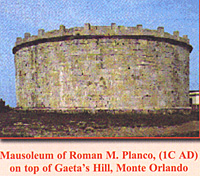 Mausoleum of Roman M. Planco, (1C AD) on top of Gaeta’s Hill, Monte Orlando
Mausoleum of Roman M. Planco, (1C AD) on top of Gaeta’s Hill, Monte Orlando
The British fleet bombarded Gaeta from 9-10 June, itself suffering in a vivid counter fire, which Begani helped to direct. Begani again lost men, not to fire but 74 more deserted to the Austrians. Begani continued counter battery fire against both the British and Austrians for the next week. Austrians made preparations to lift the siege, in case military operations against Napoleon made a retreat necessary, Major General Lauer was ordered to Gaeta in case this occurred, as was two battalions of the Spleny regiment relieving the Devaux regiment which was transferred north.
Colonel Tocco was once again at Gaeta under the orders of King Ferdinand. General Tschudy, Prince Leapold’s secretary Paolo d’Ambrosio (brother of the Murattian General) and Colonel Tocco met with Begani on 16 June. Tocco threatened Begani, stating that if surrender were not made within 3 hours then the King would treat all as traitors and rebels and be put to death. He was offered amnesty, pardon, and money to surrender Gaeta.
Begani responded by letter, stating his terms for surrender calling for immediate release (by the Austrians) of Queen Caroline and children held at Trieste, to be freed in France, and that upon his receipt of authorization by King Murat to affect surrender, then he would. British recommenced bombardment of Gaeta later the same day with the fortress of Gaeta returning fire.
The Last Neapolitan Battle Siege of Gaeta 1815
-
Fortress Gaeta
The Siege
Appendix 1: Garrison OOB
Appendix 2: Begani's Letter
Map of Gaeta (slow: 117K)
Back to Table of Contents -- First Empire # 79
Back to First Empire List of Issues
Back to MagWeb Master Magazine List
© Copyright 2004 by First Empire.
This article appears in MagWeb.com (Magazine Web) on the Internet World Wide Web. Other articles from military history and related magazines are available at http://www.magweb.com
